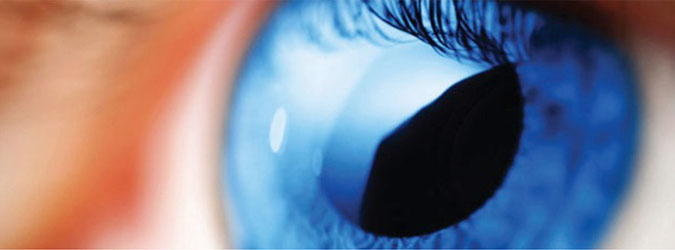
What is Glaucoma?
Glaucoma is a disease of the eye that, without treatment and early detection by your eye doctor, can lead to progressive damage to the optic nerve causing irreversible blindness or loss of vision. Glaucoma is characterized by a loss of nerve tissue that occurs when pressure builds up on the eye. The nerve tissue carries visual information from the eye to the brain and when this tissue is damaged, vision is impaired. Glaucoma usually happens in both eyes, but one eye can experience more damage than the other
Glaucoma is the second leading cause of blindness in the United States and around the world, but with early detection and treatment through visual field testing and screening, you can protect your eyes against detrimental vision loss.
Different Types of Glaucoma
Glaucoma is classified into different types:
Primary open-angle: this is the most common form of glaucoma and usually affects the peripheral vision. Despite an open angle, the fluid from the eyes does not drain properly from the angle to the canal, causing a build- up of pressure in the eye.
- Symptoms: open-angle glaucoma develops slowly and patients do not tend to notice any symptoms or loss of vision until damage has occurred. Initial symptoms are difficulty seeing things in bright light or transferring from light to dark. More severe symptoms can include severe eye pain, nausea, redness in the eye, seeing colored rings around lights, and blurred vision.
- Treatment: medicine, laser surgery, traditional surgery can help stop damage to the optic nerve but cannot cure glaucoma.
Angle-closure: this type of glaucoma is caused when fluid at the front of the eye cannot drain through the angle of the eye because the angle is blocked by part of the iris. The fluid leaves the eye, causing a sudden increase in eye pressure.
- Symptoms: severe pain and nausea, redness of the eye, and blurred vision.
- Treatment: immediate medical attention is necessary to prevent the eye from drying up and causing blindness. Prompt laser surgery and medicine may clear the blockage, lower eye pressure, and protect the vision.
Normal-tension or Low-tension: optic nerve damage and narrowed side vision occur with this type of glaucoma even in people who experience normal eye pressure.
- Symptoms: Patients do not usually report symptoms or have complaints of their vision until later diagnosis of the disease.
- Treatment: Lower the eye pressure at least 30% with medicine. This can slow the disease, but precautions must be made as glaucoma may worsen despite low pressure. Your eye doctor needs to perform a comprehensive medical history on you to identify other risk factors that may contribute to low-tension glaucoma, such as low blood pressure. Surgery and laser surgery can also be used to treat this disease.
Congenital glaucoma: a birth defect in the angle of the eye that inhibits the normal drainage of eye fluid.
- Symptoms: cloudy eyes, sensitivity to light, excessive tearing.
- Treatment: surgery is the preferred treatment as medicines are not effective, are difficult to administer, and can cause more serious side effects. Surgery is typically safe and effective, allowing children born with congenital glaucoma to have normal vision.
Secondary glaucomas: can occur as a result of another medical condition. Uncontrolled diabetes, high blood pressure, cataracts, some eye tumors, eye inflammation, uveitis, eye surgeries, severe eye injuries, and steroid drugs used that are used to treat eye inflammations and other diseases can trigger glaucoma. Pigmentary glaucoma occurs when pigments from the iris shed and block the meshwork, slowing the drainage of fluid. Pseudoexfoliation glaucoma occurs when additional material produced and sheds off internal eye structures, causing a blockage of the meshwork and further slowing fluid drainage.
If you or someone you love has any of the signs of glaucoma, it is important to seek treatment immediately. Without treatment, glaucoma can destroy the peripheral vision, causing people to become unaware of objects to the side and out of the corners of their eyes. If left untreated, tunnel vision may occur until over time, central vision may decrease, and eventually, no vision will remain.
The Relationship Between Eye Pressure and Glaucoma
Many people feel an increase in eye pressure that leads them to contact an eye doctor for a visual field screening. While increased eye pressure is one of the leading symptoms of glaucoma, glaucoma can develop without increased eye pressure. Low tension or normal-tension glaucoma is a type of open-angle glaucoma that is not characterized by an increase in eye pressure. As well, an increase in eye pressure does not necessarily signify glaucoma.
The amount of pressure an optic nerve can handle without causing damage and developing glaucoma varies with each person.
Getting your visual field screened is a necessary step in order to determine your risk of getting glaucoma. Contact your primary eye care doctor to set up an appointment to have your visual field tested
Who is susceptible to glaucoma?
Glaucoma does not discriminate and affects all age groups, including infants, children, and the elderly. However, there are some factors that make some people more susceptible to glaucoma than others.
Risk factors for Glaucoma:
- Age: People 60 years of age or older are at an increased risk for glaucoma, with a slight increase with each consecutive year of age. African Americans have a slightly higher risk for the disease beginning at age 40.
- Race: People of African American and Mexican descent have a slightly higher risk of obtaining glaucoma than Caucasians and are much more likely to suffer permanent vision loss. Angle-closure glaucoma affect more people of Asian descent while low-tension glaucoma is associated more with people of Japanese descent.
- Family history: Individuals in the same family have a higher risk of developing glaucoma if someone in the family has been diagnosed.
- Medical conditions: Diabetes, high blood pressure and heart disease have been linked to people who develop glaucoma.
- Physical injuries to the eye: Severe eye trauma can result in increased eye pressure leading to glaucoma.
- Other eye-related risk factors: Conditions such as retinal detachment, eye tumors, and eye inflammations and high amounts of near sightedness may induce glaucoma. Thin corneas, chronic eye inflammation, and certain medications can increase pressure on the eyes, increasing the risk for glaucoma.
- Corticosteroid use: The overuse of corticosteroids has been known to put some people in jeopardy of developing secondary glaucoma.
Detecting Glaucoma:
Glaucoma is detected through a comprehensive dilated eye exam by an eye care doctor and can include the following:
Visual acuity test: an eye chart that measures how well you see at various distances.
Visual field test: measures your peripheral or side vision.
Dilated eye exam: drops are placed in the patient’s eyes to dilate the pupils. A magnifying lens examines your retinas and optic nerves for signs of damage or eye problems.
Tonometry: the measurement of pressure inside the eye through the use of a tonometer.
Pachymetry: the measurement of the thickness of your cornea through the use of an ultrasonic wave instrument.
Can Glaucoma be Cured?
Unfortunately, there is no cure for glaucoma, and vision lost from the disease cannot be restored. While glaucoma cannot currently be prevented, eye doctors can diagnose and treat the symptoms early, controlling the disease. With the use of medication and surgery, glaucoma can be slowed, preventing further vision loss.
How is Glaucoma Treated?
The most successful measure to treating glaucoma is preventing it in the first place. Doctors recommend a comprehensive eye exam at least once every two years, unless you are a high risk candidate, in which case you should have more frequent eye exams. Lowering eye pressure in the early stages of glaucoma slows progression of the disease and can help prevent vision loss.
Glaucoma treatments include:
Medicines: eye drops or pills are the most prescribed treatment for the early stages of glaucoma. Taken on a regular basis, these eye drops lower eye pressure.
Laser trabeculoplasty: a procedure that helps drain fluid from the eye. Following this procedure, your doctor may prescribe medications as well.
Conventional surgery: surgery to create a new opening for the fluid to drain from the eye. This treatment usually occurs after medicines and laser surgery have failed to control the eye pressure.
Early Diagnosis is the Key to Treating Glaucoma
Glaucoma is a serious disease that, if not treated in a timely manner with appropriate visual field testing, can cause permanent blindness or loss of vision. However, with the appropriate precautionary measures, glaucoma can be prevented, avoided, or treated.
If you feel you have any of the signs of glaucoma, act immediately. Dr. Blair and his team of eye care doctors in the Burlington, Kentucky area can help put your mind at ease. Experts in diagnosing glaucoma through our visual field instruments, we can start you on your way to a healthier vision.
Contact us today to schedule an appointment.


